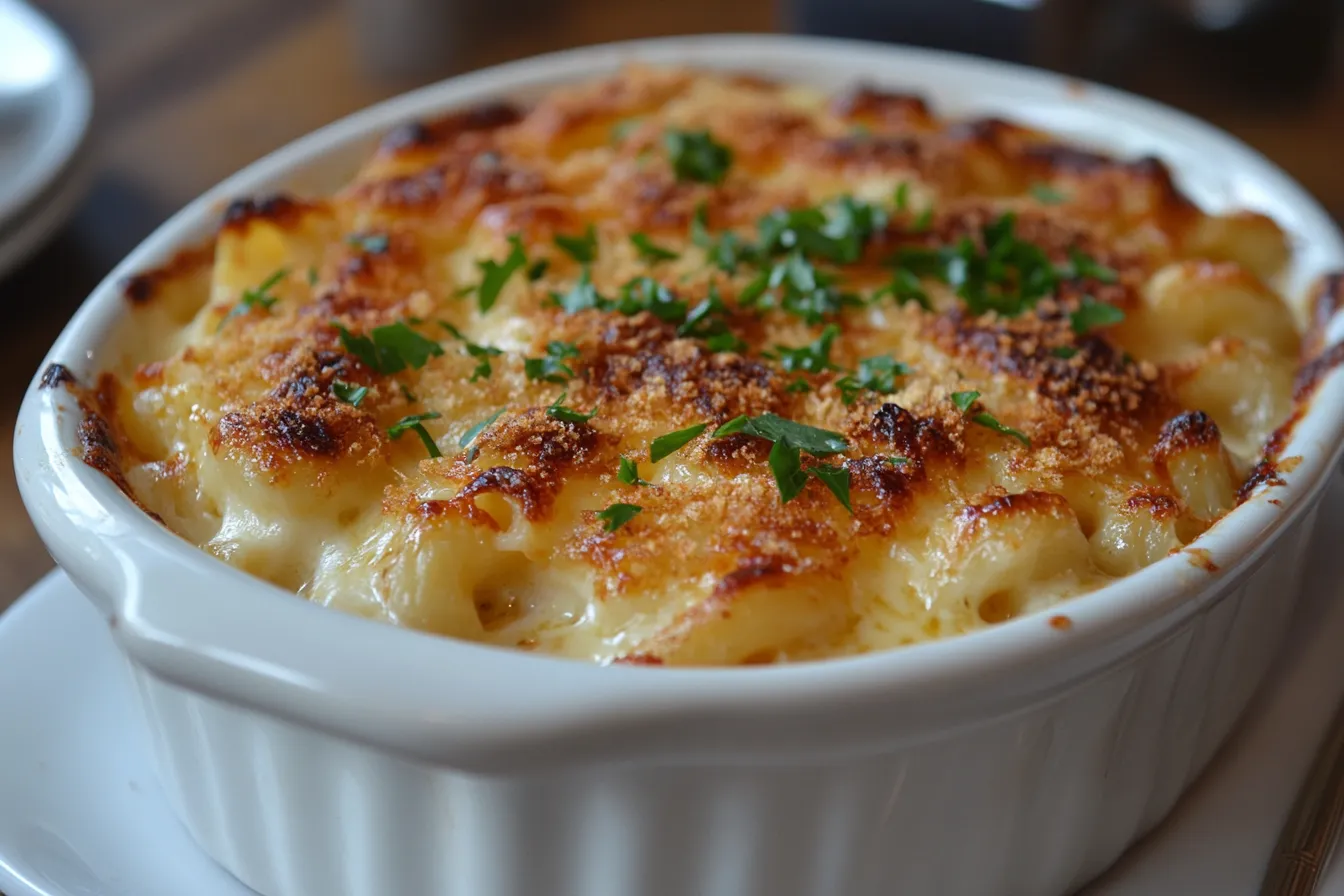Learn everything about macaroni and cheese, from its history and preparation to variations and expert tips for the perfect dish.
Macaroni and cheese is a beloved dish that has stood the test of time. Combining tender pasta with creamy, cheesy sauce, this comfort food is a favorite for all ages. Its versatility allows it to be a main dish, a side, or even a gourmet creation. In this guide, we’ll explore the history of macaroni and cheese, essential ingredients, preparation techniques, and popular variations. Additionally, you’ll find tips for storage, reheating, and customizing this classic dish to suit any taste. Moreover, its adaptability ensures it continues to evolve while remaining universally cherished.
What is Macaroni and Cheese?
At its core, macaroni and cheese is a dish made from cooked pasta combined with a creamy cheese sauce. Traditionally, it is baked with a breadcrumb topping, but there are also stovetop versions for those who prefer a quicker method. Furthermore, the recipe’s simplicity makes it accessible to cooks of all skill levels.
Macaroni and cheese dates back centuries, with early recipes appearing in European cookbooks. It gained significant popularity in the United States during the 18th century, thanks to its simplicity and satisfying taste. Over time, it has evolved from a humble dish to a versatile staple that can be dressed up or down depending on the occasion.
Today, macaroni and cheese is celebrated for its comforting qualities and adaptability. Moreover, it remains a favorite in homes, restaurants, and even upscale dining establishments. Accordingly, it continues to be a symbol of culinary comfort and innovation.
Why Macaroni and Cheese is So Popular
The enduring appeal of macaroni and cheese lies in its:
- Comforting Texture and Flavor: The creamy sauce and tender pasta create a satisfying combination that appeals to all ages.
- Customizability: From adding proteins to experimenting with gourmet cheeses, the possibilities are endless. Additionally, it’s easy to adapt the dish to suit dietary preferences.
- Ease of Preparation: With simple ingredients and straightforward steps, it’s accessible for cooks of all skill levels. Moreover, it’s forgiving and easy to experiment with.
- Versatility: It works as a quick meal, a side dish, or an impressive feature at gatherings.
Furthermore, macaroni and cheese evokes nostalgia for many, making it a go-to choice for celebrations, holidays, or casual weeknight dinners. Additionally, its universal appeal ensures it remains a beloved dish across cultures and generations.
Essential Ingredients for Macaroni and Cheese
Core Ingredients
- Pasta: Elbow macaroni is traditional, but shells, penne, and cavatappi are excellent alternatives. These shapes hold the sauce well and provide a satisfying texture.
- Cheese: Cheddar is the classic choice, but mozzarella, Gruyère, Monterey Jack, or Parmesan can enhance the flavor. Combining cheeses can create a more complex taste.
- Milk or Cream: These form the base of the sauce, providing creaminess and richness. Using a mix of cream and milk achieves the perfect consistency.
- Butter and Flour: Used to create a roux, which thickens the cheese sauce. Properly cooking the roux prevents a floury taste.
Optional Ingredients
- Breadcrumbs: Adds a crispy topping when baked. Toasting breadcrumbs with butter before adding them enhances their flavor.
- Proteins: Bacon, chicken, or even lobster can elevate the dish. Proteins turn the dish into a hearty main course.
- Vegetables: Broccoli, spinach, or peas add color and nutrition. Roasting vegetables beforehand deepens their flavor.
Substitutions
- Non-Dairy Options: Almond or oat milk and vegan cheese work well for dairy-free versions. Nutritional yeast can also provide a cheesy flavor.
- Gluten-Free Options: Use gluten-free pasta and cornstarch instead of flour for the roux. Additionally, gluten-free breadcrumbs can mimic the traditional texture.
Using high-quality ingredients ensures the best flavor and texture for your macaroni and cheese. Moreover, experimenting with different cheeses or pasta types can result in a unique and personalized dish.
Equipment Needed
- Large Pot: For boiling pasta. A heavy-bottomed pot helps prevent the pasta from sticking.
- Saucepan: To prepare the cheese sauce. Nonstick pans make cleanup easier.
- Whisk: Ensures a smooth and lump-free sauce. A silicone whisk is ideal for nonstick cookware.
- Baking Dish: Ideal for oven-baked versions. Glass or ceramic dishes distribute heat evenly.
- Cheese Grater: Freshly grated cheese melts better and provides a creamier sauce.
Having the right tools simplifies the cooking process and guarantees consistent results. Additionally, proper equipment can make preparation more enjoyable and efficient.
Step-by-Step Guide to Making Macaroni and Cheese
1. Preparing the Pasta
- Choose a pasta shape that holds sauce well, such as macaroni or shells. These shapes trap cheese sauce in their crevices for maximum flavor.
- Cook the pasta in salted water until al dente. Drain and set aside. Cooking pasta to the right consistency prevents it from becoming mushy during baking.
2. Making the Cheese Sauce
- Melt butter in a saucepan over medium heat. Stir frequently to prevent burning.
- Whisk in flour to form a roux. Cook for 1-2 minutes, stirring constantly. This step removes the raw taste of the flour.
- Gradually add milk, whisking to prevent lumps. Simmer until thickened. This step ensures a smooth base for the cheese.
- Stir in grated cheese until melted and smooth. Season with salt, pepper, and optional spices like paprika or mustard powder. Adding these spices enhances the overall flavor profile.
3. Assembling and Baking
- Combine the pasta with the cheese sauce, ensuring even coating. Mixing thoroughly helps distribute the sauce evenly.
- Transfer to a greased baking dish. Top with breadcrumbs and additional cheese if desired. The breadcrumbs add a delightful crunch.
- Bake at 375°F for 20-25 minutes, or until bubbly and golden. Rotating the dish halfway through ensures even cooking.
4. Serving Suggestions
- Serve hot, garnished with fresh herbs or a sprinkle of Parmesan. Fresh garnishes elevate the presentation.
- Pair with a side salad or roasted vegetables for a balanced meal. These sides complement the richness of the dish.
Popular Variations of Macaroni and Cheese
Classic Baked Macaroni and Cheese
- Description: A traditional version topped with breadcrumbs and baked to perfection.
- Why It’s Popular: The crispy topping adds texture to the creamy base. Additionally, it’s ideal for gatherings and potlucks.
Stovetop Macaroni and Cheese
- Description: A quick, creamy version made entirely on the stovetop.
- Why It’s Popular: Ideal for busy weeknights or when you’re short on time. Its simplicity makes it a favorite for families.
Gourmet Macaroni and Cheese
- Description: Features upscale ingredients like Gruyère, truffle oil, or lobster.
- Why It’s Popular: Perfect for special occasions or impressing guests. The addition of luxurious ingredients transforms it into a fine dining experience.
Vegan Macaroni and Cheese
- Description: Made with plant-based cheese and non-dairy milk.
- Why It’s Popular: A delicious option for vegans or those with dietary restrictions. It’s also an excellent way to incorporate healthy, cruelty-free ingredients.
Each variation offers a unique twist, catering to different preferences and occasions. Experimenting with these variations allows for endless creativity in the kitchen.
Serving Suggestions
- Side Dishes: Complement macaroni and cheese with garlic bread, coleslaw, or steamed vegetables. These options provide balance and additional flavors.
- Toppings: Add crispy bacon bits, caramelized onions, or hot sauce for extra flavor. Creative toppings can enhance the dish’s appeal.
- Drinks to Pair: Serve with iced tea, beer, or a crisp white wine. These beverages pair well with the creamy texture.
Storing and Reheating Macaroni and Cheese
Proper Storage
- Refrigerate leftovers in an airtight container for up to four days. Proper storage ensures freshness.
- Freeze for up to three months. Portion into smaller containers for convenience. Freezing prevents waste and makes future meals easier.
Reheating Tips
- Reheat in the oven at 350°F, covered with foil, to prevent drying out. Adding a splash of milk restores creaminess.
- For quick reheating, use a microwave on medium power. Stirring halfway through prevents uneven heating.
Proper storage and reheating ensure your macaroni and cheese remains as delicious as when freshly made. These methods also preserve the dish’s creamy texture.
Health and Nutrition Information
While traditional macaroni and cheese is indulgent, there are ways to make it healthier:
- Calorie Content: A typical serving has 300-500 calories, depending on ingredients. Using low-fat options can reduce the calorie count.
- Protein and Calcium: High in both, thanks to the cheese and milk. Including lean proteins further boosts nutritional value.
- Healthier Substitutions: Use whole-grain pasta, reduced-fat cheese, and add vegetables for extra nutrients. These changes make the dish more balanced.
Balancing indulgence with healthy ingredients allows you to enjoy this comfort food guilt-free. Moreover, incorporating nutrient-rich add-ins enhances its overall appeal.
Common Mistakes and How to Avoid Them
- Clumpy Cheese Sauce: Avoid overheating the cheese and whisk continuously while adding milk. Gradual heating prevents curdling.
- Overcooked Pasta: Cook pasta to al dente to prevent it from becoming mushy. Draining promptly helps maintain texture.
- Bland Flavor: Use a mix of cheeses and seasonings to enhance the dish. Tasting as you go ensures balanced seasoning.
Following these tips ensures a creamy, flavorful macaroni and cheese every time. Attention to detail during preparation guarantees consistent success.
Frequently Asked Questions (FAQs)
How do you make homemade macaroni and cheese?
Prepare a cheese sauce with a roux, combine with cooked pasta, and bake or serve as is.
What are the best cheeses to use in macaroni and cheese?
Cheddar, Gruyère, Monterey Jack, and Parmesan are excellent choices for flavor and meltability.
Can you freeze macaroni and cheese?
Yes, freeze it in airtight containers for up to three months. Reheat in the oven with added milk to restore creaminess.
What are some variations of macaroni and cheese recipes?
Try classic baked, stovetop, gourmet with upscale ingredients, or vegan versions for dietary needs.
How can I make macaroni and cheese healthier?
Use whole-grain pasta, low-fat cheese, and add vegetables like spinach or broccoli.
Is macaroni and cheese suitable for vegetarians?
Yes, as long as you use vegetarian cheese and avoid adding meat.
Can you make macaroni and cheese gluten-free?
Yes, use gluten-free pasta and substitute cornstarch for flour in the roux.
What is the best pasta shape for macaroni and cheese?
Elbow macaroni, shells, and cavatappi are ideal for holding sauce.
How do you prevent macaroni and cheese from drying out?
Add enough sauce, cover while reheating, and use a splash of milk or cream.
Can you make macaroni and cheese without milk?
Yes, use alternatives like chicken broth, almond milk, or oat milk for a creamy texture.
Conclusion
Macaroni and cheese is a timeless comfort food beloved for its rich flavors, creamy textures, and endless versatility. By understanding its history, mastering its preparation, and exploring creative variations, you can make a dish that suits any occasion. Whether enjoyed as a quick meal or an elegant centerpiece, macaroni and cheese remains a dish that brings joy and satisfaction to every table. Try these tips and variations to elevate your next serving and share the experience with family and friends.
For more Lunch recipes, check out our Lunch Recipes for more ideas.

